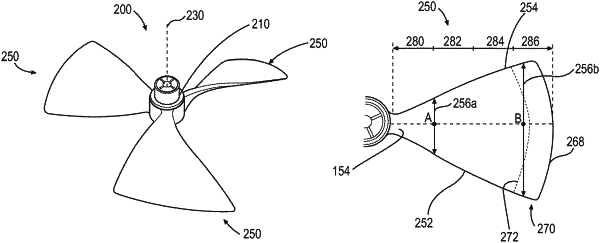| CPC B64C 11/18 (2013.01) [B64C 39/024 (2013.01)] | 15 Claims |

|
1. A propeller comprising:
a central hub mountable for drivable rotation about a central axis of rotation; and
at least one blade extending from the central hub and rotatable about the central axis of rotation by the central hub to generate a backward airflow;
wherein the at least one blade,
extends from a proximal attachment end attached to the central hub to a blade tip, distal from the central hub;
comprises a leading edge extending from the proximal attachment end to the blade tip, and a trailing edge extending from the proximal attachment end to the blade tip;
comprises a front surface extending between the leading edge and the trailing edge from the proximal attachment end to the blade tip, and a back surface extending between the leading edge and the trailing edge from the proximal attachment end to the blade tip; and
at each point along the blade from the proximal attachment end to the blade tip, the blade:
defines a mean camber line extending between the leading edge and the trailing edge halfway between the front surface and the back surface; and
defines a chord line extending straight between the leading edge and the trailing edge, wherein a chord length of the chord line varies along the blade from the proximal attachment end to the blade tip, the at least one blade defining a maximum chord length in a blade tip region of the blade at a location spaced proximally from the blade tip, the blade tip region extends from a proximal border to the blade tip, and the proximal border is located toward the blade tip by at least 75% of a distance from the proximal attachment end to the blade tip,
wherein the blade defines a maximum camber between 3% and 10% of the chord length at each point along the blade in the blade tip region, and the maximum camber equals a maximum distance from the mean camber line to the chord line at any point along the blade from the leading edge to the trailing edge.
|